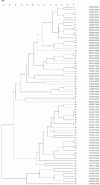Automated high-throughput mycobacterial interspersed repetitive unit typing of Mycobacterium tuberculosis strains by a combination of PCR and nondenaturing high-performance liquid chromatography
- PMID: 15365008
- PMCID: PMC516338
- DOI: 10.1128/JCM.42.9.4175-4180.2004
Automated high-throughput mycobacterial interspersed repetitive unit typing of Mycobacterium tuberculosis strains by a combination of PCR and nondenaturing high-performance liquid chromatography
Abstract
Mycobacterial interspersed repetitive unit-variable number tandem repeat (MIRU-VNTR) typing of Mycobacterium tuberculosis complex isolates is portable, 100% reproducible, and highly discriminatory. Nondenaturing high-performance liquid chromatography (non-dHPLC) with use of a WAVE microbial analysis system is a promising method of PCR amplicon analysis as it is low cost and requires no preanalysis processing. The aims of this study were to validate the application of WAVE microbial analysis system technology to MIRU-VNTR typing. A collection of 70 strains were cultivated in liquid culture and extracted using the QIAamp DNA minikit. Novel primers were designed to target the 12 MIRU-VNTR loci (P. Supply et al., J. Clin. Microbiol. 39:3563-3571, 2001). After amplification, each PCR product was analyzed on a WAVE microbial analysis system. The fragment size was calculated from the chromatogram, and the number of tandem repeats at each locus was determined. For the collection of 70 strains 100% concordance was achieved when comparing MIRU-VNTR profiles obtained from agarose gel electrophoresis and PCRs analyzed on a WAVE microbial analysis system. The calculated fragment sizes, obtained from the WAVE microbial analysis system, were sufficiently accurate to ensure 100% confidence when assigning the number of tandem repeats to a MIRU-VNTR locus. This study is the first to report the successful use of non-dHPLC for screening for variations in the number of MIRU-VNTRs in mycobacterial DNA. Non-dHPLC analysis was demonstrated to be a rapid, low-labor input method for the detection and analysis of MIRU-VNTR amplicons. The combination with non-dHPLC further enhances the utility of MIRU-VNTR typing.
Figures
Similar articles
-
Utility of fast mycobacterial interspersed repetitive unit-variable number tandem repeat genotyping in clinical mycobacteriological analysis.Clin Infect Dis. 2004 Sep 15;39(6):783-9. doi: 10.1086/423383. Epub 2004 Aug 27. Clin Infect Dis. 2004. PMID: 15472808
-
Characterization of Mycobacterium tuberculosis Central Asian Strain 1 using mycobacterial interspersed repetitive unit genotyping.BMC Microbiol. 2007 Aug 9;7:76. doi: 10.1186/1471-2180-7-76. BMC Microbiol. 2007. PMID: 17686185 Free PMC article.
-
Molecular characterization of Sardinian Mycobacterium tuberculosis isolates by IS6110 restriction fragment length polymorphism, MIRU-VNTR and rep-PCR.New Microbiol. 2010 Apr;33(2):155-62. New Microbiol. 2010. PMID: 20518277
-
[New era in molecular epidemiology of tuberculosis in Japan].Kekkaku. 2006 Nov;81(11):693-707. Kekkaku. 2006. PMID: 17154049 Review. Japanese.
-
Molecular methods for Mycobacterium tuberculosis strain typing: a users guide.J Appl Microbiol. 2003;94(5):781-91. doi: 10.1046/j.1365-2672.2003.01918.x. J Appl Microbiol. 2003. PMID: 12694442 Review.
Cited by
-
Validation and implementation of whole-genome sequencing-based analytical methods for molecular surveillance and relatedness analysis of Mycobacterium tuberculosis complex isolates at a national reference laboratory.Heliyon. 2024 Nov 8;10(22):e40279. doi: 10.1016/j.heliyon.2024.e40279. eCollection 2024 Nov 30. Heliyon. 2024. PMID: 39641035 Free PMC article.
-
Determination of antibiotic resistance and high-performance liquid chromatography profiles for Mycobacterium species.J Clin Lab Anal. 2018 Sep;32(7):e22459. doi: 10.1002/jcla.22459. Epub 2018 Apr 27. J Clin Lab Anal. 2018. PMID: 29701251 Free PMC article.
-
Systematic survey of clonal complexity in tuberculosis at a populational level and detailed characterization of the isolates involved.J Clin Microbiol. 2011 Dec;49(12):4131-7. doi: 10.1128/JCM.05203-11. Epub 2011 Sep 28. J Clin Microbiol. 2011. PMID: 21956991 Free PMC article.
-
Mycobacterium tuberculosis is the causative agent of tuberculosis in the southern ecological zones of Cameroon, as shown by genetic analysis.BMC Infect Dis. 2013 Sep 13;13:431. doi: 10.1186/1471-2334-13-431. BMC Infect Dis. 2013. PMID: 24028382 Free PMC article.
-
First worldwide proficiency study on variable-number tandem-repeat typing of Mycobacterium tuberculosis complex strains.J Clin Microbiol. 2012 Mar;50(3):662-9. doi: 10.1128/JCM.00607-11. Epub 2011 Dec 14. J Clin Microbiol. 2012. PMID: 22170917 Free PMC article.
References
-
- Collyns, T. A., D. M. Gascoyne-Binzi, and P. M. Hawkey. 2002. Molecular fingerprinting of Mycobacterium tuberculosis: does it help in understanding the epidemiology of tuberculosis? Rev. Med. Microbiol. 13:119-127.
-
- Cooksey, R. C., G. P. Morlock, B. P. Holloway, J. Limor, and M. Hepburn. 2002. Temperature-mediated heteroduplex analysis performed by using denaturing high-performance liquid chromatography to identify sequence polymorphisms in Mycobacterium tuberculosis complex organisms. J. Clin. Microbiol. 40:1610-1616. - PMC - PubMed
MeSH terms
Substances
LinkOut - more resources
Full Text Sources


